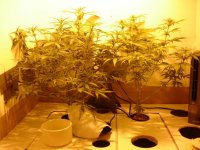I would hope this would equalizing the EC in the container (and reservoir below). Salts will go from high concentration to low, so you too may have salts moving down from the top to the bottom. If there is a path of moisture and the top builds up salt, I think it can make it's way down by osmosis.D9's PPK design makes use of the pulse feed to maintain media solution uniformity and stability. If you are top feeding based on sub-water-table-level by way of a water sensor, you may be allowing salts to come out of solution at the top of your media. When you do top feed, it seems possible that you will then flush them back into the bottom reservoir, thereby altering the concentrations of your feed batch. Can you adjust for this? Probably.
Even if the upward water flow or somethng else stops the salts, I was thinking it a good thing to have some leaching of the top of the containers on a regular basis.
If I'm understanding things right, my way would simply flush the media. The other way has some water going in to keep it wet but no water makes it from the top to the bottom.
How do you handle this problem? Right now I have top feed drip lines with small sprinkler like things that throw the water out from the center a few inches. I would like to set it up so I can actually flood the pot, but I don't have a manifold that I can use for 1/2 tubbing.That said, I feel that this addition undermines the elegance of D9's current design.
Of course, the comments above presumes that your plant uptake is such that there is a drying cycle in the upper zone of the media between the on-off top feed cycle.
If your plant is drinking faster, then you are saturation feeding more often... and whatever comes of that comes of that.
You may be flushing root exudates into the feed batch. Whatever comes out of that comes out of that (but those sugars do feed microbes...).
If you plants are feeding unevenly, do you set up individual top-feed-controlling valves for each plant?
I am using wicks to bottom waterIf you have a failure in the pump or control system, you have no passive back up to maintain the plant until you realize the what went wrong and take corrective action.
---
As you can see from this post, I strongly favor a float controlled lower reservoir, with automated pulse feedings compared to what you are suggesting.
---
I do not want to sound like I'm arbitrarily defending the existing PPK tech like some kind of adoring devotee.
Not to say that I'm not an adoring devotee.
But there is a cohesiveness in D9's design. Your proposed system is different from D9's, but might suit your needs and existing equipment better. Hell, it might grow better plants for reasons other than those I noted above.
Either way, I'd like to follow your progress. Start a thread with whatever design you choose?
Yea, I am really open to changing things. After reading some of the university research I'm starting to see that a small amount of dialing in say air gap can make significant diff in total yield.





